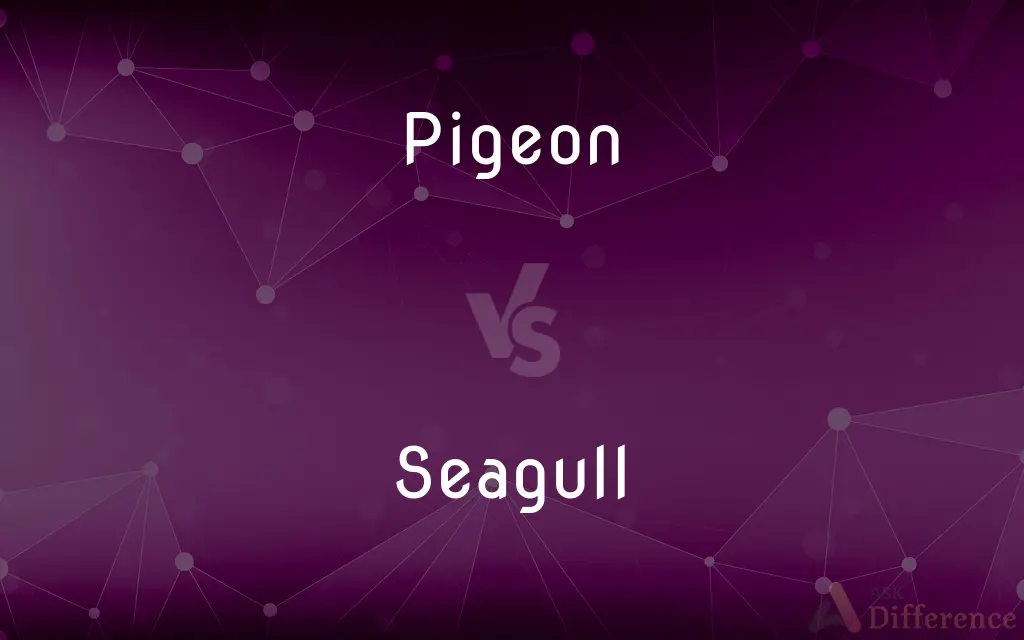Pigeon vs. Seagull — What's the Difference?
By Maham Liaqat & Fiza Rafique — Updated on March 25, 2024
Pigeons, known for their adaptability to urban environments, are smaller, often gray birds, famous for their cooing sounds. Seagulls, associated with coastal areas, are larger, primarily white with gray or black markings, and known for their loud calls.

Difference Between Pigeon and Seagull
Table of Contents
ADVERTISEMENT
Key Differences
Pigeons and seagulls are two distinct bird species commonly encountered by people, each with unique characteristics and behaviors. Seagulls, part of the Laridae family, are typically associated with marine environments but can also be found inland, near bodies of water.
Pigeons, belonging to the family Columbidae, are highly adaptable birds found in urban and rural areas worldwide. Unlike pigeons, seagulls are opportunistic feeders and are known to exhibit clever behaviors to obtain food, such as dropping shellfish on rocks to crack them open.
While pigeons are often seen as symbols of peace or messengers due to their historical use in communication, seagulls are frequently associated with the sea and coastal life. Both species have adapted well to human environments, but they have distinct social behaviors and communication methods. Pigeons tend to be more docile and can be trained, which is why they were used in the past for carrying messages. Seagulls, however, are more aggressive, particularly when defending their territory or competing for food.
The habitats of pigeons and seagulls overlap in urban coastal areas, where they can be seen coexisting, though their interactions are generally competitive due to their different lifestyles and food sources. Conservation efforts for both species focus on maintaining their natural habitats and managing their populations in urban areas to prevent overpopulation and associated problems.
Comparison Chart
Family
Columbidae
Laridae
ADVERTISEMENT
Size
Smaller, compact
Larger, with longer wingspan
Color
Often gray, with varied coloration
Primarily white with gray/black markings
Sound
Gentle cooing
Loud, harsh squawking
Habitat
Urban and rural areas worldwide
Coastal areas, though can be inland near water
Behavior
Docile, can be trained
Opportunistic, more aggressive
Diet
Seeds, grains, human food scraps
Fish, insects, food scraps, shellfish
Association
Peace, communication
Sea, coastal life
Compare with Definitions
Pigeon
Often gray, with a varied diet including seeds and scraps.
The family fed grains to pigeons at the park.
Seagull
Known for their loud, squawking calls.
The sound of squawking seagulls filled the air at the seaside.
Pigeon
Associated with peace and used historically as messengers.
Pigeons were used to carry messages in wars.
Seagull
Exhibits clever behaviors to obtain food.
A seagull dropped a shellfish on the rocks to crack it open.
Pigeon
A small to medium-sized bird known for living in close proximity to humans.
Pigeons flocking in the city square are a common sight.
Seagull
A larger bird primarily found in coastal areas, recognizable by its white and gray plumage.
Seagulls were soaring above the beach, looking for food.
Pigeon
Adaptable to both urban and rural environments.
Pigeons nesting on building ledges have adapted well to city life.
Seagull
Opportunistic feeders that consume a wide range of foods.
Seagulls scavenging for food scraps at the picnic area can be quite aggressive.
Pigeon
Known for their gentle cooing sound.
The cooing of pigeons is a familiar background noise in urban areas.
Seagull
Associated with the sea and coastal life.
The presence of seagulls is a telltale sign of being near the ocean.
Pigeon
A stout seed- or fruit-eating bird with a small head, short legs, and a cooing voice, typically having grey and white plumage.
Seagull
A gull, especially one found near coastal areas.
Pigeon
A gullible person, especially someone swindled in gambling or the victim of a confidence trick.
Seagull
Any of several white, often dark backed birds of the family Laridae having long pointed wings and short legs.
Pigeon
An aircraft from one's own side.
Seagull
(orthography) The symbol ̼ , which combines under a letter as a sort of accent.
Pigeon
Archaic spelling of pidgin
Seagull
A fan or member of Brighton and Hove Albion Football Club.
Pigeon
A person's particular responsibility or business
Hermia will have to tell them first, it's her pigeon
Seagull
To run in the back line rather than concentrate on primary positional duties in open play.
Pigeon
Any of various birds of the widely distributed family Columbidae, characteristically having plump bodies, small heads, and short legs, especially the rock pigeon or any of its domesticated varieties.
Seagull
To use a British Seagull outboard.
Pigeon
(Slang) One who is easily swindled; a dupe.
Seagull
(New Zealand) To work as a non-union casual stevedore.
Pigeon
An object of special concern; an affair or matter.
Seagull
Mostly white aquatic bird having long pointed wings and short legs
Pigeon
One of several birds of the family Columbidae, which consists of more than 300 species.
Pigeon
(uncountable) The meat from this bird.
Pigeon
A person who is a target or victim of a confidence game.
Pigeon
A pacifist, appeaser, an isolationist, a dove.
Pigeon
A person hired to transport film footage out of a region where transport options are limited.
Pigeon
A weak or useless person.
Pigeon
Concern or responsibility.
It's his/her pigeon.
Pigeon
(transitive) To deceive with a confidence game.
Pigeon
Any bird of the order Columbæ, of which numerous species occur in nearly all parts of the world.
Pigeon
An unsuspected victim of sharpers; a gull.
Pigeon
To pluck; to fleece; to swindle by tricks in gambling.
He's pigeoned and undone.
Pigeon
Wild and domesticated birds having a heavy body and short legs
Common Curiosities
Why do pigeons often bob their heads when they walk?
Pigeons bob their heads to stabilize their visual surroundings. This motion helps them maintain balance and navigate more effectively by providing a steady visual flow.
How do pigeons and seagulls contribute to the ecosystem?
Both species play significant roles in their ecosystems. Pigeons help control populations of seeds and insects, acting as a natural cleanup crew. Seagulls also help control populations of fish and insects, and their scavenging helps in the decomposition process, contributing to nutrient cycling in their habitats.
Are seagulls protected by law?
In many countries, seagulls and their nests are protected under wildlife conservation laws, making it illegal to harm or disturb them, especially during the breeding season. Regulations can vary, so local guidelines should be consulted.
How do pigeons and seagulls differ in their diet?
Pigeons primarily eat seeds and grains, while seagulls have a more varied diet that includes fish and shellfish.
What efforts are being made to conserve these birds?
Conservation efforts focus on protecting natural habitats and managing urban populations to ensure their health and prevent conflicts with humans.
Can seagulls drink saltwater?
Yes, seagulls can drink saltwater. They have special glands above their eyes that filter out the salt, which is then excreted through their nostrils, allowing them to live in saline environments without dehydration.
How do pigeons navigate over long distances?
Pigeons possess remarkable navigational skills, using a variety of cues, including the Earth's magnetic field, the sun, stars, and landmarks. Studies also suggest they may use infrasound (low-frequency sounds) and smell.
Which bird is more aggressive?
Seagulls are generally more aggressive, especially when it comes to defending territory or competing for food.
Do pigeons and seagulls migrate?
Some seagull species migrate, but pigeons typically stay close to their home area throughout the year.
Can both pigeons and seagulls be found in cities?
Yes, both species have adapted well to urban environments, though pigeons are more commonly associated with city life.
Can pigeons and seagulls live in the same environment?
Yes, they can coexist, especially in urban coastal areas, though their interactions are mainly competitive.
Are pigeons or seagulls smarter?
Both species exhibit intelligence, but seagulls are particularly noted for their problem-solving abilities in obtaining food.
Share Your Discovery

Previous Comparison
Nat vs. Pat
Next Comparison
Problem vs. ComplaintAuthor Spotlight
Written by
Maham LiaqatCo-written by
Fiza RafiqueFiza Rafique is a skilled content writer at AskDifference.com, where she meticulously refines and enhances written pieces. Drawing from her vast editorial expertise, Fiza ensures clarity, accuracy, and precision in every article. Passionate about language, she continually seeks to elevate the quality of content for readers worldwide.














































